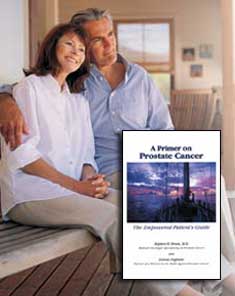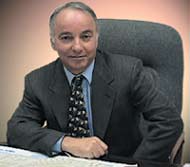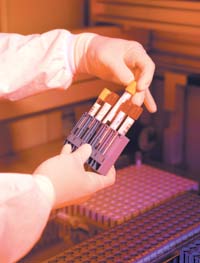 Empowering
Prostate Patients
Empowering
Prostate Patients
Partner
of a warrior in the battle against prostate cancer and co-author of A
Primer on Prostate Cancer, The Empowered Patient's Guide, Donna Pogliano
tells Life Extension her story, from diagnosis to
triumph.
I
was poised for good news. My partner Dick leads a charmed life. Nothing serious
ever happens to him. Yes, there was the time he had a persistent cough and spots
on his lungs that looked like cancer, but it turned out to be just a fungus. We
had chased that one down with three different lung biopsies, all negative. Frustrated,
his RN daughter suggested a PSA test just in case this was metastasized prostate
cancer.
The
PSA test came back at just over 6. Then the lung culture came back positive for
blastomycosis (fungal infection). Relieved, we put the "slightly elevated" PSA
test out of our minds, almost forgetting the doctor's suggestion to recheck it
in a year. Fortunately, my memory was jogged by the diagnosis of a neighbor who
told me he was going to be treated for prostate cancer using a permanent seed
implant procedure.
I'm
an incurable optimist, so when Dick phoned me at work to tell me that his PSA
had risen to 10.5 and the doctor recommended a biopsy, I was unprepared. He'd
just done a 21-day bicycle trip, riding 1600 miles from Milwaukee to Florida to
celebrate his 70th birthday. He was healthier than many people half his age. And
he had no symptoms.
I
was prepared to hear that the biopsy was negative. It wasn't. He again phoned
me at work. I'd clicked on the icon for the Internet practically before I hung
up the phone. I wanted to know how soon he was going to die, what treatment he
would need, and what death from prostate cancer was going to be like for us. And
I wanted to know right then!
The
Treatment
By
the time I left the office, I'd found what I was looking for. Something to reassure
Dick and give him some ray of hope. I printed out a ream of material after skimming
it quickly to find the answers I wanted most. I was reassured to read that most
men die "with" prostate cancer rather than "of" it. I figured we could somehow
cope with anything short of death. I found information about treatment options
and side effects and told Dick all about what I'd found.
The
treatment my neighbor had looked good to me. Not too invasive, a quick little
outpatient procedure. I read the books the urologist gave us, but they were written
when seed implants were just a promising new treatment. The internist knew of
a good brachytherapist (doctor who performs radiation therapy in which radioactive
sources are implanted directly into a malignant tumor.). I grilled these two doctors
relentlessly on every aspect of prostate cancer I could think of. By the time
seed implant day rolled around, they were both thoroughly sick of me. I knew too
much, but not quite enough, and I asked a lot of questions. Nevertheless, on my
son's fourteenth birthday, December 13, 1999, which we considered lucky, Dick's
prostate was implanted with 79 radioactive iodine seeds and then he was sent home.
The
Commitment
Radiation
patients have to wait a long time to find out if their treatment works, and there
can be "bumps" along the way. I wanted to be prepared. I joined discussion lists
on the Internet, where groups of people share information. By this time, I had
acquired enough information to offer education to other newly diagnosed, confused
and frightened men and their partners. Some were fathers who looked to their children
to navigate the maze of information and tell them what to do.
One
such diligent child provided the inspiration for a document that would change
my life. In March 2000, I asked a woman from one of the Internet discussion lists
if I could pass along some of her advice to the daughter of a newly diagnosed
man. It was then that I realized that all of us who advised other patients had
been spending a lot of time reinventing the wheel, typing the same time-honored
advice over and over again. Why not put all the information that represents our
best advice into one document?
Three
months later, I had compiled what I thought was the minimum base of information
that a newly diagnosed man and his family should have before making a treatment
decision. I wrote the first draft. I typed all night long until 5 a.m., when with
a lump in my throat, I added the closing benediction: "We wish you low PSAs, and
may your days be long and good upon the earth."
The
Serendipity
Dr.
Stephen Strum had won my admiration and respect for his messages to the Internet
mailing list. I was most impressed by Dr. Strum's compassion and caring for the
patient-his altruism and sensitivity. "You must be the change you wish to see
in the world," he said, quoting Gandhi. Yes, I wanted to be that change.
|

I
was most impressed by Dr. Strum's compassion and caring for the patient-his altruism
and sensitivity.
Pictured:
Dr. Stephen Strum
|
|
I
had been working on a project to get all 50 of the state governors to proclaim
September as Prostate Cancer Awareness Month. Seeking help in getting volunteers,
I e-mailed Dr. Strum, a medical Oncologist, asking if he could help. To my surprise,
he invited me to phone him at home.
He
was very cordial and I tried to be at ease, but I stuttered my way through my
request. To my amazement, he grilled me about my project and my motives, explaining
that his time was valuable. Stunned, I searched my mind for something to say.
Some credential to prove me worthy. I mentioned that I was working to develop
a document to be used as a tool to educate newly diagnosed patients. It would
be called A Primer on Prostate Cancer. He seemed satisfied and commented that
he would be willing to give it his now infamous "Virgo review." The rest is history.
Stephen
and I are now bemused by the fact that if I had simply declined to accept his
offer, it would have changed both our lives forever. We marvel over the serendipity
that caused me to mention this unrelated project in the course of that fateful
phone call.
The
Goal
The
goal of the Primer was always to educate the patient. From the beginning, when
the patient review process began, to the early support and funding by the Prostate
Cancer Research Institute, of which Stephen Strum is a co-founder, to the generous
and freely given support of The Life Extension Foundation the goal was to serve
the patient. We sought to produce a work to dispell the fear and confusion of
the patient and replace it with knowledge and empowerment. Our graphic designer
Russ Gould of US TOO! who put up with endless refinements and stuck his neck out
for us to extend our deadline, and our loved ones who sacrificed their time to
proofread the manuscript are all to be commended for never losing sight of the
goal of serving the patient.
The
full-color printing makes the book beautiful as well as extremely readable. It
is a "happy book" that "wants to be read," as Stephen had envisioned. The information
is extremely comprehensive, with information to satisfy the novice prostate cancer
patient and the serious student of prostate cancer alike.

|
|
The
goal of the Primer was always to educate the patient. In meeting every challenge,
everyone involved in the project was attendant to the goal of serving the patient.
From early beginnings, when the patient review process began, to the early support
and funding by the Prostate Cancer Research Institute
|
|
Important
areas of text are color coded to identify proactive issues, areas of concern and
cautionary notes. Similar to a workbook, each chapter has a cut-to-the-chase summary
at the end entitled "What You Should Have Learned From This Chapter." And there
are lots of places provided throughout the text for the reader to jot down notes.
For the serious student of prostate cancer there is the "If You Want To Know More"
appendix with more in-depth information on various topics than is covered in the
main text. "Physician's Notes" drawn from Dr. Stephen Strum's experiences in clinical
practice as an expert medical oncologist specializing in prostate cancer further
illustrate, by example, some of the principles presented.

"We'd
done it. We'd turned my simple little project into a 368-page full-color book…
Our moment in the sun. We did everything wrong, but somehow, it turned out right.
Readers of the Primer will be better prepared than we were. Perhaps Dick does
lead a charmed life after all. I know I do."
|
|
Fully
referenced and indexed, with a glossary, and other appendices containing the Partin
tables (accumulated data from hundreds of prostate cancer patients), illustrations
of the clinical stages of prostate cancer, and a resource list for further investigation
into topics of interest, this is a reference work that should be on the bookshelves
of doctors and patients alike and in public libraries, medical libraries and medical
facilities everywhere.
The
rationales for using various treatment options are explained, as well as Dr. Stephen
Strum's overall strategy for successful disease management. Basic information
to help patients cope with the diagnosis, to deal with their doctors, and to understand
basic anatomy is presented. Current treatment options and their effects are discussed,
as well as treatments on the horizon. Since one of the co-authors is a medical
oncologist specializing in prostate cancer who has had decades of experience in
treating patients with androgen deprivation therapy, there is extensive information
regarding the purpose behind, and proper use of that treatment as well as discussion
regarding how best to deal with its side effects.
Whatever
the reader might be looking for, odds are, it's in this book, plus more.
The
Triumph
Stephen's
60th Birthday: September 17th, 2002. As a birthday present to Stephen, I issued
a pronouncement. "We are done. Finished. Complete. The End." Stephen gave the
order to start the presses. All that was left to do was to wait for the Fed Ex
containing the finished book. Finally it arrived. We'd done it. We'd turned my
simple little project into a 368-page full-color book. On October 5th I got on
a plane to Los Angeles with Dick beside me, healthy and happy. We went to a prostate
cancer conference where Stephen was the keynote speaker. We had the Primer premiere
and book signing. Our moment in the sun.
We
did everything wrong, but somehow, it turned out right. Readers of the Primer
will be better prepared than we were. Perhaps Dick does lead a charmed life after
all. I know I do.